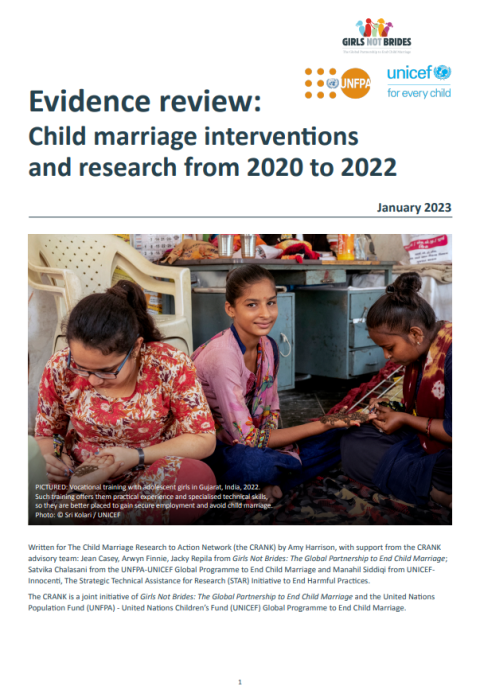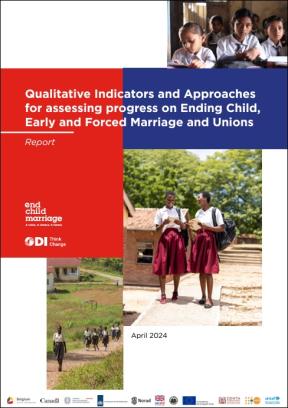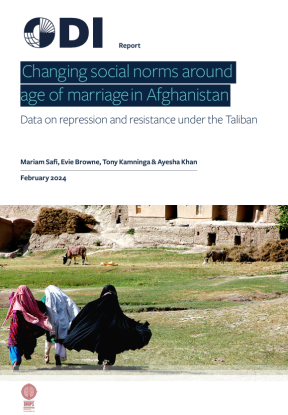- Briefing paper
- 8 February 2023
Evidence review: Child marriage interventions and research from 2020 to 2022
- Author: ESubden
- Published by: Girls Not Brides

The evidence landscape on child marriage
The evidence base on child marriage has grown dramatically in recent years, yet significant gaps in our knowledge remain – particularly around what works to prevent and respond to child marriage, how to address it in conflict and crisis settings, and how best to respond to the specific risks to girls and adolescents facing intersecting forms of marginalisation.
What’s in this review
This review looks at emerging evidence on proven and promising interventions to prevent child marriage and support girls who are married, divorced, separated or widowed, and/or are young mothers. It also includes suggestions for future research, programming, policy and funding.
It covers evidence ranging from large-scale, public systems and services-focused interventions, to community-based programming in both development and humanitarian contexts, organised by theme. It also includes suggestions for future research, programming, funding, and policy and advocacy.
All stakeholders working on child marriage can read this document for:
- A synthesis of the evidence on what works to prevent child marriage and support married girls since 2020, including in conflict and crisis settings (including climate change).
- Recent examples of promising interventions and practices, including around girls’ education; livelihoods and economic rights; sexual and reproductive health and rights; voice, choice and agency; social norms change; women’s rights organisations and feminist movements; legal reform and gender responsive budgeting; and intersectionality and inclusion.
- Key takeaways from each thematic area, highlighting strengths and weaknesses of different approaches, and evidence gaps.
- Recommendations for future research, programming, funding, and policy and advocacy.
Some key takeaways
Education
- Education may be a non-negotiable component of successful multicomponent programming to prevent child marriage, and may have the greatest potential to also influence positive change around other protective factors, including health-seeking behaviours.
Livelihoods and economic rights
- Pairing social protection or cash transfer interventions with a component that aims to shift restrictive norms around traditional gender roles can have a transformative, longer-term effect on perceptions around girls’ and women’s worth, and may improve adolescent girls’ and women’s access to life skills opportunities and employment.
Sexual and reproductive health and rights
- Female health workers can increase trust in and uptake of services, and act as role models in a way that may have a positive impact on girls’ and adolescents’ broader wellbeing and development.
- The SRHR needs of married girls and young mothers may be most effectively addressed through multi-component programmes that also address the psychosocial, economic and norms-based barriers they may face in accessing healthcare.
Voice, choice and agency
- Grounding activities in local systems and context, and supporting girls to access programme activities – including through financial support for girls and their caregivers, and through engagement with husbands, male family members, and community members – are likely necessary ingredients for programme success.
Shifting individual and collective norms
- Engaging boys and men as potential allies for change, as a key focus within a whole-household or whole-community approach, is likely important for shifting harmful norms or sustaining behaviour change over the longer term.
- Fear, stigma and the desire to control adolescent girls’ sexuality is a key driver of child marriage, yet is often not included in child marriage programming.
Women’s rights organisations and feminist movements
- There is an ever-growing evidence base showing the influential role WROs and feminist movements can play in pushing for and achieving tangible progress towards gender equality.
Legal frameworks and gender-responsive budgeting
- While there is a link between minimum age of marriage laws and reduced prevalence, laws should only be considered as one part of a holistic response that includes other thematic, awareness-raising or norms-based elements.
Intersectionality and inclusion
- While more evidence is needed to understand how certain marginalised and minoritized groups experience (the risk of) child marriage, there are also lessons that can be learnt from other relevant programming in terms of how to ensure their safe and meaningful inclusion in programming.
Climate change, conflict and crises
- More evidence is needed on the relationship between climate change and child marriage, prioritising countries that face the greatest threats from or are the most vulnerable to climate change.
- There is a growing body of positive evidence on flexible, creative approaches to providing SRH services to adolescent girls in humanitarian settings.
- Tags:
- Child marriage
- Countries / Regions:
- Global
Related resources
Journal article
26 July 2024

Report
8 May 2024

Report
22 February 2024
